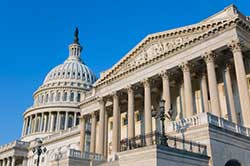The Open Access Wrecking Ball
First published in The Hill on July 13, 2016
July 15, 2016 | Michael S. Lubell
If taxpayers pay for something, they have a right to see what they bought without paying a nickel more for the privilege. That’s the argument proponents of “open access” make when it comes to scientific research supported by the federal government.
And it’s one of the primary drivers of S. 779, the Fair Access to Science and Technology Research (FASTR) Act, which would make all federally funded research articles freely available to anyone who wants to read them.
Sounds appealingly simple. But it isn’t. Here’s why.
In an age of electronic communication, everyone expects to have access to information on the Web instantly and without using a credit card to get it. But in reality, Web content is never free.
If a reader isn’t paying for the content, advertisers or content owners invariably are, although not always so obviously. And for truly high-quality content, such as New York Times or Wall Street Journal articles, pay walls are more the rule than the exception. If you want access to those publications, you have to pony up to read them.
Today that same kind of controlled access exists for most research journals. They maintain high standards with careful editing, peer review, composition and archiving at considerable cost. Of course, what sets most of them apart from newspapers, magazines and books is that much of their content is based on publicly funded research.
The open access proposition is that readers who have paid for the research should not pay again to learn about the discoveries. But if readers don’t pay, authors will have to. Unfortunately, pending legislation and regulations do not recognize the financial burden they will have to bear. Nor do they recognize that the financial burden will fall unevenly.
Let’s take a look at the financial context.
Today, the federal government spends about $60 billion on research, split almost evenly between the life sciences (principally biomedicine) and the physical sciences, including engineering and computation. The size of the research grants federal agencies make varies substantially: from $50,000 a year or less to $500,000 a year or more, depending on the research field and the size of the research team.
But for illustrative purposes, consider a median National Science Foundation grant size of about $130,000 a year. Such a grant might support two graduate students and generate between two and four research papers a year. In today’s world, where subscribers pay for access to those papers, the grant does not have to allocate any money to the cost of publication.
But in an open access world, where authors would bear the cost of publishing their work, such a grant would have to be taxed for that purpose. And the tax would not be small.
Although publication costs would vary from journal to journal, an average of $3,000 per manuscript in an open access world is not an unreasonable estimate. For our illustrative $130,0000 grant, the publication tax would be close to 10 percent. That money would come at the expense of student support and research activity.
But in many scientific fields — theoretical particle physics is a good example — grants are far smaller, even though the number of papers published per year is about the same. In the case of a $50,000 annual grant, for example, the publication tax would rise to almost 25 percent.
In all cases, the impact would be significant, but in some cases it would be devastating. To alleviate the adverse impact, federal research budgets would have to rise, other sources of publication funds would have to be found or the quality of science publications would have to be compromised.
Each of these options is fraught with significant challenges. The current outlook for federal budgets is far from rosy, and increasing science agency appropriations to cover publication costs will be a heavy lift. Having universities redirect money they currently spend on library journal subscriptions to author publication charges is a compelling proposition, but there are no obvious enforcement mechanisms. And allowing the quality of scientific publications to suffer — by eliminating peer review, for example — would find few adherents within the scientific community.
Since there is no clear path forward without pitfalls, Congress should ask the National Academy of Sciences to carry out a detailed study of the challenges created by open access with recommendations for a viable approach that minimizes the damage to the U.S. science enterprise.
Michael S. Lubell is director of public affairs of the American Physical Society and the Mark W. Zemansky Professor of Physics at the City College of the City University of New York. He writes and speaks widely about scientific research and science policy.

Policy news and viewpoints for the physics community. The analysis and opinions are those of the APS Office of Public Affairs and do not necessarily represent the entire Society.
